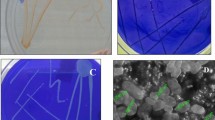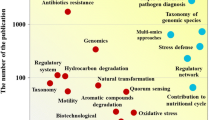Abstract
A novel bacterium, Cr-10, was isolated from a chromium-contaminated site and capable of removing toxic chromium species from solution by reducing hexavalent chromium to an insoluble precipitate. Sequence analysis of 16S rRNA gene of strain Cr-10 showed that it was most closely related to Serratia rubidaea JCM 1240T (97.68%). Physiological and chemotaxonomic data also supported that strain Cr-10 was identified as Serratia sp., a genus which was never specially reported chromate-resistant before. Serratia sp., Cr-10 was tolerant to a concentration of 1,500 mg Cr(VI) L−1, which was the highest level reported until now. The optimum pH and temperature for reduction of Cr(VI) by Serratia sp. Cr-10 were found to be 7.0 and 37 °C, respectively. The Cr(VI) reduction was significantly influenced by additional carbon sources, and among them fructose and lactose offered maximum reduction, with a rate of 0.28 and 0.25 mg Cr(VI) L−1 h−1, respectively. The cell-free extracts and filtrate of the culture were able to reduce Cr(VI) while concentration of total chromium remained stable in the process, indicating that the enzyme-catalyzed mechanism was applied in Cr(VI) reduction by the isolate. Additionally, it was found that there was hardly any chromium on the cell surface of the strain, further supporting that reduction, rather than bioadsorption, plays a major role in the Cr(VI) removal.




Similar content being viewed by others
References
Ackerley DF, Gonzalez CF, Park CH, Blake R, Keyhan M, Matin A (2004) Chromate-reducing properties of soluble flavoproteins from Pseudomonas putida and Escherichia coli. Appl Environ Microbiol 70:873–882
Alvarez AH, Moreno-Sanchez R, Cervantes C (1999) Chromate efflux by means of the ChrA chromate resistance protein from Pseudomonas aeruginosa. J Bacteriol 181:7398–7400
Beadregard DA, Yong P, Macaskie LF, Johns ML (2010) Using non-invasive magnetic resonance imaging (MRI) to assess the reduction of Cr(VI) using a biofilm-palladium catalyst. Biotechnol Bioeng 107:11–20
Bernardet JF, Nakagawa Y, Holmes B (2002) Proposed minimal standards for describing new taxa of the family Flavobacteriaceae and emended description of the family. Int J Syst Evol Microbiol 52:1049–1070
Brown SD, Thormpson MR, Verberkmoes NC, Chourey K, Shah M, Zhou J, Hettich RL, Thompson DK (2006) Molecular dynamics of the Shewanella oneidensis response to chromate stress. Mol Cell Proteomics 5:1054–1071
Chourey K, Thormpson MR, Morrell-Falvey J, Verberkmoes NC, Brown SD, Shah M, Zhou J, Doktycz M, Hettich RL, Thompson DK (2006) Global molecular and morphological effects of 24-hour chromium(VI) exposure on Shewanella oneidensis MR-1. Appl Environ Microbiol 72:6331–6344
Chun J, Lee JH, Jung Y, Kim M, Kim S, Kim BK, Lim YW (2007) EzTaxon: a web-based tool for the identification of prokaryotes based on 16S ribosomal RNA gene sequences. Int J Syst Evol Microbiol 57:2259–2261
Felsenstein J (1985) Confidence limits on phylogenies: an approach using the bootstrap. Evolution 39:783–791
Grimont PAD, Grimont F, Starr MP (1979) Serratia ficaria sp. nov., a bacterial species associated with Smyrna figs and the fig wasp Blastophaga psenes. Curr Microbiol 2:277–282
Hu P, Brodie EL, Suzuki Y, McAdams HH, Andersen GL (2005) Whole-genome transcriptional analysis of heavy metal stresses in Caulobacter crescentus. J Bacteriol 187:8437–8449
Juhnke S, Peitzsch N, Hubener N, Grosse C, Nies DH (2002) New genes involved in chromate resistance in Ralstonia metallidurans strain CH34. Arch Microbiol 179:15–25
Llagostera M, Garrido S, Guerrero R, Barbe J (1986) Induction of SOS genes of Escherichia coli by chromium compounds. Environ Mutagen 8:571–577
Luli GW, Talnagi JW, Strohl WR, Pfister RM (1983) Hexavalent chromium-resistant bacteria isolated from river sediments. Appl Environ Microbiol 46:846–854
Magnuson TS, Swenson MW, Paszczynski AJ, Deobald LA, Kerk D, Cummings DE (2010) Proteogenomic and functional analysis of chromate reduction in Acidiphilium cryptum JF-5, an Fe(III)-respiring acidophile. Biometal 23:1129–1138
Malik A (2004) Metal bioremediation through growing cells. Environ Int 30:261–278
McLean JS, Beveridge TJ, Phipps D (2000) Isolation and characterization of a chromium-reducing bacterium from a chromated copper arsenate-contaminated site. Environ Microbiol 2:611–619
Miranda AT, Gonzalez MV, Gonzalez G, Vargas E, Campos-Garcia J, Cervantes C (2005) Involvement of DNA helicases in chromate resistance by Pseudomonas aeruginosa PAO1. Mutat Res 578:202–209
Pattanapipitpaisal P, Brown NL, Macaskie LE (2001) Chromate reduction and 16S rRNA identification of bacteria isolated from a Cr(VI)-contaminated site. Appl Microbiol Biotechnol 57:257–261
Rainey FA, Ward-Rainey N, Kroppenstedt RM, Stackebrandt E (1996) The genus Nocardiopsis represents a phylogenetically coherent taxon and a distinct actinomycete lineage: proposal of Nocardiopsaceae fam. nov. Int J Syst Bacteriol 46:1088–1092
Ramirez-Diaz MI, Diaz-Perez C, Vargas E, Riveros-Rosas H, Campos-Garcia J, Cervantes C (2008) Mechanisms of bacterial resistance to chromium compounds. Biometals 21:321–332
Saitou N, Nei M (1987) The neighbor-joining method: a new method for reconstructing phylogenetic trees. Mol Biol Evol 4:406–425
Sau GB, Chatterjee S, Mukherjee SK (2010) Chromate reduction by cell-free extract of Bacillus firmus KUCr1. Pol J Microbiol 59:185–190
Srivastava S, Thakur IS (2007) Evaluation of biosorption potency of Acinetobacter sp. for removal of hexavalent chromium from tannery effluent. Biodegradation 18:637–646
Szulczewski MD, Helmke PA, Bleam WF (2001) XANES spectroscopy studies of Cr(VI) reduction by thiols in organosulfur compounds and humic substances. Environ Sci Technol 35:1134–1141
Tamura K, Dudley J, Nei M, Kumar S (2007) MEGA4: Molecular Evolutionary Genetics Analysis (MEGA) software version 4.0. Mol Biol Evol 24:1596–1599
Thacker U, Parikh R, Shouche Y, Madamwar D (2007) Reduction of chromate by cell-free extract of Brucella sp. isolated from Cr(VI) contaminated sites. Bioresour Technol 98:1541–1547
Thompson JD, Gibson TJ, Plewniak F, Jeanmougin F, Higgins DG (1997) The CLUSTAL_X windows interface: flexible strategies for multiple sequence alignment aided by quality analysis tools. Nucleic Acids Res 25:4876–4882
Acknowledgments
We thank Dr. Shu Xia for providing chromate-contaminated soil samples.
This work was supported by the Research Network for Applied Microbiology grant from Chinese Academy of Sciences.
Author information
Authors and Affiliations
Corresponding author
Electronic supplementary material
Below is the link to the electronic supplementary material.
Table S1
Soil samples used in this study were collected from chromate-contaminated sites (DOC 31 kb)
Table S2
Identification of the isolates based on 16S rRNA gene sequences and their Cr(VI)-resistant ability (DOC 35 kb)
Table S3
The EDS result of the cell surface of strain Cr-10 (DOC 32 kb)
Rights and permissions
About this article
Cite this article
Zhang, K., Li, F. Isolation and characterization of a chromium-resistant bacterium Serratia sp. Cr-10 from a chromate-contaminated site. Appl Microbiol Biotechnol 90, 1163–1169 (2011). https://doi.org/10.1007/s00253-011-3120-y
Received:
Revised:
Accepted:
Published:
Issue Date:
DOI: https://doi.org/10.1007/s00253-011-3120-y




